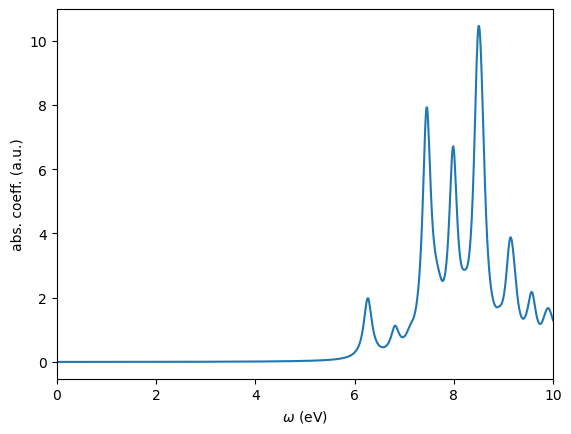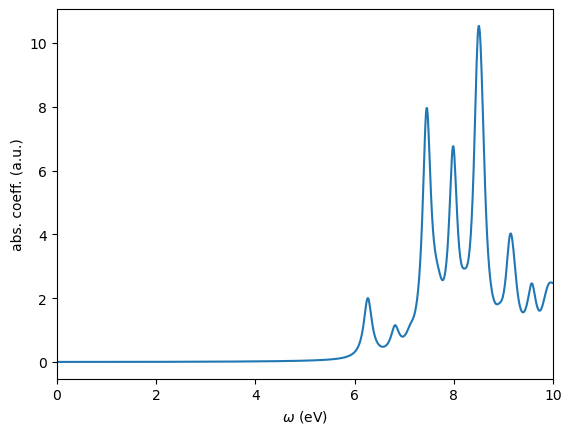This tutorial can be downloaded link.
Intro Tutorial 11: Computing Absorption Spectra Using Time-Dependent Density Functional Theory (TDDFT)
This tutorial shows how to compute the absorption spectrum of the ethene (C\(_2\)H\(_4\)) molecule using linear-response time-dependent density functional theory (TDDFT) within the Tamm-Dancoff approximation. WEST implements two distinct methods to compute the absorption spectrum:
the Davidson approach, which iteratively diagonalizes the Liouville superoperator and uses its eigenvalues and eigenvectors to calculate the absorption spectrum;
the Lanczos approach, which computes an effective tri-diagonalization of the Liouville superoperator and uses its resolvent to calculate the absorption spectrum over a broad energy range.
More details about the TDDFT implementation in WEST can be found in Y. Jin, V. Yu, M. Govoni, A. Xu, and G. Galli, J. Chem. Theory Comput. 19, 8689–8705 (2023).
In this tutorial, the TDDFT calculations are conducted using the semi-local PBE functional. See Tutorial 10 for TDDFT calculations using hybrid functionals.
Step 1: Mean-field starting point
We first perform the DFT calculation using the Quantum ESPRESSO code.
Download the following files to your working directory:
[ ]:
%%bash
wget -N -q http://www.quantum-simulation.org/potentials/sg15_oncv/upf/C_ONCV_PBE-1.2.upf
wget -N -q http://www.quantum-simulation.org/potentials/sg15_oncv/upf/H_ONCV_PBE-1.2.upf
wget -N -q https://west-code.org/doc/training/ethene/pw.in
We can inspect the pw.in file, the input for the pw.x code:
[1]:
%%bash
cat pw.in
&control
calculation = 'scf'
pseudo_dir = './'
/
&system
ibrav = 1
celldm(1) = 30.0
nat = 6
ntyp = 2
ecutwfc = 25.0
nbnd = 50
assume_isolated = 'mp'
/
&electrons
diago_full_acc = .TRUE.
/
ATOMIC_SPECIES
C 12.011 C_ONCV_PBE-1.2.upf
H 1.00784 H_ONCV_PBE-1.2.upf
ATOMIC_POSITIONS angstrom
C 6.842010 7.500000 7.500000
H 6.261924 6.560696 7.500000
H 6.261924 8.439284 7.500000
C 8.180848 7.500000 7.500000
H 8.761131 6.560806 7.500000
H 8.761131 8.439200 7.500000
K_POINTS gamma
We run pw.x on 2 cores.
[ ]:
%%bash
mpirun -n 2 pw.x -i pw.in > pw.out
Step 2: Calculation of absorption spectrum using the Davidson method
We run the wbse.x executable to compute the excitation energies of the low-lying excited states of C\(_2\)H\(_4\). Download the following file to your working directory:
[ ]:
%%bash
wget -N -q https://west-code.org/doc/training/ethene/davidson_wbse.in
Let us inspect the davidson_wbse.in file:
[2]:
%%bash
cat davidson_wbse.in
input_west:
qe_prefix: pwscf
west_prefix: davidson
outdir: ./
wbse_init_control:
wbse_init_calculation: S
solver: TDDFT
wbse_control:
wbse_calculation: D
n_liouville_eigen: 100
n_liouville_maxiter: 1000
trev_liouville: 0.000001
trev_liouville_rel: 0.0001
l_preconditioning: True
l_pre_shift: True
The wbse_calculation: D keyword instructs the code to diagonalize the Liouville superoperator using the Davidson method, obtaining the leading eigenvalues and eigenvectors. The n_liouville_eigen: 100 keyword specifies that the first 100 eigenvalues are computed.
We run wbse.x on 2 cores:
[ ]:
%%bash
mpirun -n 2 wbse.x -i davidson_wbse.in > davidson_wbse.out
We run the westpp.x executable to compute the transition dipole moments (TDMs) of the low-lying excited states of C\(_2\)H\(_4\). Download the following file to your working directory:
[ ]:
%%bash
wget -N -q https://west-code.org/doc/training/ethene/davidson_westpp.in
Let us inspect the davidson_westpp.in file:
[3]:
%%bash
cat davidson_westpp.in
input_west:
qe_prefix: pwscf
west_prefix: davidson
outdir: ./
westpp_control:
westpp_calculation: C
westpp_n_liouville_to_use: 100
westpp_range: [1, 100]
westpp_l_compute_tdm: True
The westpp_calculation: C keyword instructs the code to decompose the leading eigenvectors in terms of pairs of occupied and empty Kohn-Sham orbitals. The westpp_n_liouville_to_use: 100 and westpp_l_compute_tdm: True keywords specify that the TDMs of the first 100 low-lying excited states are computed.
We run westpp.x on 2 cores:
[ ]:
%%bash
mpirun -n 2 westpp.x -i davidson_westpp.in > davidson_westpp.out
The output can be found in the file davidson.westpp.save/westpp.json. If the reader does NOT have the computational resources to run the calculations, the output file can be directly downloaded as:
[ ]:
%%bash
mkdir -p davidson.westpp.save
wget -N -q https://west-code.org/doc/training/ethene/westpp.json -O davidson.westpp.save/westpp.json
We use the WESTpy Python package to parse this file and plot the absorption coefficient as a function of the photon frequency.
[4]:
from westpy.bse import *
davidson_result = BSEResult("davidson.westpp.save/westpp.json")
davidson_result.plotSpectrum(ipol="XYZ",energyRange=[0.0,10.0,0.01],sigma=0.1,fname="davidson_XYZ.png")
_ _ _____ _____ _____
| | | | ___/ ___|_ _|
| | | | |__ \ `--. | |_ __ _ _
| |/\| | __| `--. \ | | '_ \| | | |
\ /\ / |___/\__/ / | | |_) | |_| |
\/ \/\____/\____/ \_/ .__/ \__, |
| | __/ |
|_| |___/
WEST version : 5.5.0
Today : 2024-02-01 15:10:57.307555
plotting absorption spectrum (Davidson)
output written in : davidson_XYZ.png
waiting for user to close image preview...

Step 3: Calculation of absorption spectrum using the Lanczos method
We run the wbse.x executable to compute the absorption spectrum of C\(_2\)H\(_4\) using the Lanczos method. Download the following file to your working directory:
[ ]:
%%bash
wget -N -q https://west-code.org/doc/training/ethene/lanczos_wbse.in
Let us inspect the lanczos_wbse.in file:
[5]:
%%bash
cat lanczos_wbse.in
input_west:
qe_prefix: pwscf
west_prefix: lanczos
outdir: ./
wbse_init_control:
wbse_init_calculation: S
solver: TDDFT
wbse_control:
wbse_calculation: L
wbse_ipol: XYZ
n_lanczos: 3000
n_steps_write_restart: -1
The wbse_calculation: L keyword instructs the code to compute the absorption spectrum using the Lanczos algorithm. The wbse_ipol: XYZ keyword specifies which components of the polarizability tensor are computed, where XYZ means that three Lanczos chains are sequentially performed to compute the full polarizability tensor.
We run wbse.x on 2 cores:
[ ]:
%%bash
mpirun -n 2 wbse.x -i lanczos_wbse.in > lanczos_wbse.out
The output can be found in the file lanczos.wbse.save/wbse.json. If the reader does NOT have the computational resources to run the calculations, the output file can be directly downloaded as:
[ ]:
%%bash
mkdir -p lanczos.wbse.save
wget -N -q https://west-code.org/doc/training/ethene/wbse.json -O lanczos.wbse.save/wbse.json
We use WESTpy to parse this file and plot the absorption coefficient as a function of the photon frequency.
[6]:
lanczos_result = BSEResult("lanczos.wbse.save/wbse.json")
lanczos_result.plotSpectrum(ipol="XYZ",energyRange=[0.0,10.0,0.01],sigma=0.1,n_extra=97000,fname="lanczos_XYZ.png")
plotting absorption spectrum (Lanczos)
output written in : lanczos_XYZ.png
waiting for user to close image preview...

The spectra computed with the Davidson and Lanczos methods closely align with each other, as anticipated. Although the two methods are theoretically expected to produce identical absorption spectra, each has its unique advantages and disadvantages.
The Davidson approach is particularly beneficial when it’s necessary to explicitly determine the eigenvalues and eigenvectors of a few low-lying excited states, such as in the analysis of excited state potential energy surfaces. This method is also capable of identifying “dark” excited states, which are dipole forbidden. However, its application is less suited for studying the absorption spectrum over a broad energy range in large systems due to the significant computational demands associated with computing a large number of eigenvalues and eigenvectors of the Liouville superoperator.
Conversely, the Lanczos approach excels in computing the absorption spectrum for large systems across a wide energy range. However, it does not provide direct insights into the composition of excited states.
Users should choose the appropriate method based on their specific requirements and the nature of the system under study.